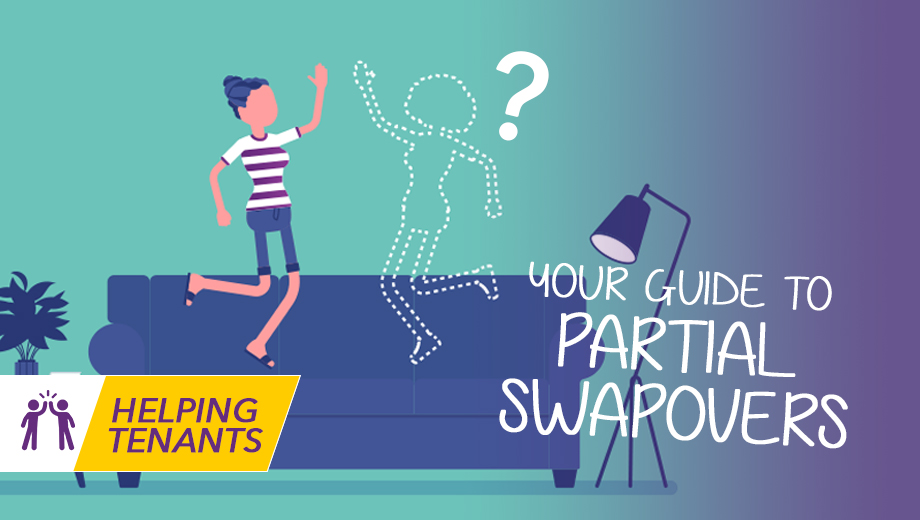Your flatmate wants to move out but you want to stay… what happens?
First of all, it’s important to understand the kind of tenancy agreement you signed when you first moved in. All tenancies created after 1st December 2017 are Private Rented Tenancies (PRT). Under a PRT, all tenants are ‘jointly and severally liable’; meaning that all tenants (and guarantors, if any are named on the tenancy agreement) are equally liable for the property and for the terms of the tenancy agreement (importantly including payment of rent).
We understand that people’s circumstances change all the time, and there are a lot of reasons why someone would need or want to move out. We also understand that this doesn’t necessarily apply to all tenants in a property.
When one tenant wants to leave, a new tenancy agreement needs to be created without their name on it. This is what we call a ‘partial tenancy swapover’ (check us out!)
What’s a partial tenancy swapover?
This is a straight swap of one tenant for another. Because the lease is joint and severally liable, once the old tenant(s) wants to move out, we’ll need to create a fresh lease for the remaining tenant(s) and the tenant(s) who’ll be moving in. The new tenancy will also be joint and severally liable, so it’s important that the new tenant(s) are aware that they’re not only responsible for their own room, but the whole property.
The landlord isn’t under an obligation to allow a swapover, so we’ll need to get their approval before we can go ahead with one. The landlord is also charged for a swapover and it requires admin work on our side, so we generally only allow one swapover every six months as an absolute maximum – tenants should pick their new flatmate(s) carefully and inform them on the process, as no one wants a last minute change of plans!
How much time do tenants have?
We need the current tenants to inform their Relationship Manager at least two weeks before they plan to leave and they want a new tenant to take their place. The new tenancy will always fall on the current rent due date, so the tenants will need to take this into consideration. Tenant reference checks can take up to ten days to complete, so it’s vital we have time to complete these before the new tenancy starts.
Will there be any changes in the new tenancy agreement?
Apart from updating the name(s) of the new tenant(s) – generally, no. The landlord, however, is able to review the rent at the start of a new tenancy. So it’s a good idea for the remaining tenants to double-check with their Relationship Manager if there’ll be any rent increase before they try to find a new flatmate.
It’s also important to note that the incoming tenant will need to take on the current inventory from when the original tenants move into the property. Therefore, we would always recommend new tenants check over the property fully and make sure they’re happy with the condition of the flat as they will be joint & severally liable for the condition of the whole property.
What happens when a new tenant has been chosen?
Easy – they’ll go through the exact same checks we perform on all our new tenants. First, we’ll ask them to complete their Offer To Let form (this is so the landlord knows who’ll be moving in) and pay their share of the deposit. Then they’ll have to complete their Online Application and their Amiqus ID reference checks, before we send out the new lease. This means it’s really important to choose someone who’ll be reliable and organised, as the vacating tenant will be liable right up until the new lease is signed.
We’ve written a blog post that goes into detail about the referencing process here, so if the new tenant has any questions or concerns, they might find it a helpful read.
What happens to the vacating tenant(s) deposit?
We’re always sorry to see our tenants go, but we understand they won’t be with us forever and we hope they enjoyed their time with us!
Once the new tenant has paid their deposit and signed the new lease, we’ll contact Safe Deposit Scotland to let them know who’s moving out. The vacating tenant will receive an email asking them to accept their deposit share back (they’ll need to log into Safe Deposit Scotland for this, but their website is dead helpful if the vacating tenant has lost their login details). They’ll also ask how best to pay this share back, so the tenant will need to keep a close eye on their emails.
If a tenant has already moved out, does that mean they aren’t liable for the property?
I’m afraid not – the joint and severally liable part of the lease means that, even if someone has moved out of the property, they’ll still be jointly liable with the remaining tenant for the rent. We’ll do everything we can to process the swapover as quickly as possible on our side, but we would encourage tenants to communicate with each other with regards to how the process is going.
We hope this helps show how a tenancy swapover works, and why we ask for the information we do, but if you have any questions we’re always happy to have a chat over the phone or through email!
If you’re tenants who are all looking to move out of a property together but have some friends looking to take your place, take a look at our blog on Full Tenancy swap overs which will be more relevant to you.
